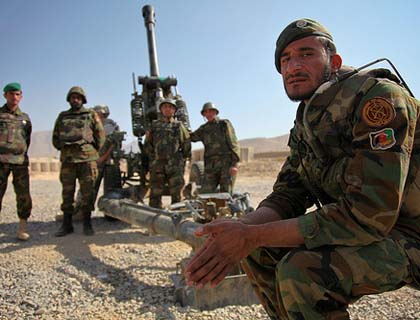KABUL- The Afghan National Security Forces (ANSF) may soon be in charge of security for nearly half of their population, under plans for the second stage of a security transfer that NATO nations hope will serve as firm evidence their troops can come home on deadline.
Foreign nations fighting in Afghanistan have agreed with Afghan President Hamid Karzai that all combat soldiers will leave by the end of 2014. They are organizing a years-long handover to consolidate Afghan control more effectively.
Being able to say that around half of Afghans rely on their countrymen for security would be a simple milestone Western leaders could use to show war-weary voters back home that progress is being made after a decade of fighting.
"This is important to many of the troop contributing countries as a way to show that they are making progress towards bringing troops home, or getting Afghanistan to a position where their soldiers really can leave," said one senior Western diplomat of the new handover plans.
The transition began this summer, when Afghan forces were officially put in charge of a handful of provinces and cities, and Karzai is expected to announce the areas that will make up the second stage of the transition within weeks.
Diplomats and military officials say the proposed regions together account for around half of the population — though not all may make the final selection.
Even the most modest proposals are expected to leave two out of every five Afghans living in areas where responsibility for security has been transferred to Afghans, even with barely a quarter of the country provinces handed over in their entirety.
The most ambitious will cover half the population; at present around a quarter of Afghans live in areas under Afghan control. The final say lies with Karzai and his officials.
"If President Karzai approves the recommendations that are coming forward to him get close to 45 percent of the Afghan population in areas where the Afghan Security forces are in the lead," said a senior NATO official, speaking on condition of anonymity to discuss sensitive issues.
CHALLENGING AREAS
Implementation of the deal could start as soon as December, the NATO official said, with the announcement expected to come ahead of a major international conference on the future of Afghanistan, to be held in Germany on Dec. 5.
Many of the areas chosen for the first stage of the handover, such as fiercely anti-Taliban Bamyan and Panjsher provinces, were considered more showpieces than challenges.
The provincial capital of southern Helmand province, a Taliban stronghold that has seen years of fierce fighting, was included in part to forestall these criticisms but the army unit posted there was among the best trained and equipped.
The next set of areas is expected to include swathes of largely peaceful northern Afghanistan, but also some more violent eastern and central areas, closer to Taliban heartlands or insurgent safe havens in Pakistan.
How the army and police handle a greater, and more widely spread, burden of responsibility, may affect how fast the rest of the country can be handed over.
The NATO official named parts of Wardak and Ghazni provinces, which lie west and southwest of the capital Kabul and have a heavy insurgent presence, as among the possible transition areas, along with a district of Helmand. (Reuters)

